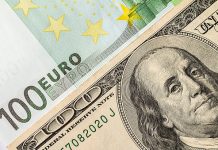News and Events:
AUD ready for debasement
The Australian dollar has been the best performing currency among the G10 complex since the beginning of the year. The Aussie rose more 6% against the greenback and recovered from around $0.72 to around $0.77 at the beginning of February. This sustainable appreciation of the Aussie is mostly the results of two factors: Firstly, the broad dollar depreciation was especially marked against high-yielding currencies such as the Aussie and the Kiwi but also against safe haven currencies such as the Japanese yen and the Swiss franc. Secondly, the sharp increase in iron prices – together with the broad-based recovery in commodity prices – has helped boost expectations for the country’s growth outlook. Indeed, the Aussie is highly dependent on exports (around 20% of GDP) and its dependence on China’s health is also very high as roughly 34% (12-month average) of its exports go to the “Middle Kingdom”.
Despite this encouraging note, dark clouds are gathering on the horizon as the two factors mentioned above are losing momentum. Indeed, China’s iron ore port inventory rose dramatically this year and reached almost 130 million tons as of February 24th. On the other hand, over the same period, steel production continued to inch lower, suggesting that there is a strong imbalance between demand and supply. Finally, on a trade-weighted basis the Aussie is back to levels last seen in summer 2015, which makes the RBA very unhappy with the situation. Indeed, the central bank has reiterated many times that the Aussie is overvalued and may be ready to take some action to adjust this situation. Taking into account the two factors exposed above, we believe that the Aussie rally has come to an end and that a correction is looming. We do not exclude the RBA to cut rates next week but in our opinion it appears very unlikely as US-AUD rates continue to converge. We anticipate AUD/USD to return quickly toward $0.75 and do not rule out further weakness for the pair should the dollar rally continue with $0.74 as the next target.
Overvalued ILS
Expectation for a 25bp Fed rate hike in March has surged to approximately 80% probability from 30% only two weeks ago. US short-end yields have risen 5-10bp, giving USD further support (US 2yr yields now at 1.28%). Global stock markets continue to rally with the Dow ripping through the 21k level. The catalyst remains shaky as traders are pointing to the conciliatory President Trump joint session of congress address as providing markets time to focus on solid US economic data and hawkish Fed rhetoric. Incoming data from the manufacturing sectors indicates steady improvement as ISM manufacturing index increased to 57.5 against 56.2 expectations. EM currencies have been surprisingly resilient to the USD rally given the importance of US rates as primary driver of EM FX. Given the rise in rates we are suspect that the Israeli Shekel (ILS) strength against the USD is overdone. The Bank of Israel has been in a defensive position fighting to weaken the ILS. The central bank has purchased $50 million in January totaling around $2.6bn in foreign currencies. While on Monday, the BoI held it benchmark interest rates at 0.1% focusing on the weak inflation outlook rather than on solid growth. The Israeli economy accelerated above expectations to 4% in 2016, yet data suggests a deceleration in 2017 (especially factoring the uncompetitive ILS). Current central bank projections indicate a 15bp hike in Q4 and another in 2018. A widening US-ILS yields spread suggests that USDILS should trade higher near-term.
Bank of Canada keeps rates unchanged
Yesterday the USDCAD surged above 1.33 after the Bank of Canada held rates its unchanged at 0.5%.
We believe that the BoC is still in wait and see mode since Donald Trump’s ascension to the oval office. The Fed is now expected to increase rates by March and there is clear monetary policy divergence between the US and Canada for the time being.
Trump’s policies are likely to weigh on the Canadian economy and the key issue remains around the NAFTA (North American Free Trade Agreement), which is likely to be renegotiated. The global outlook has not changed much and what the new US president will deliver is of very high interest for Canadian policymakers.
In any case, one cannot blame Trump for subdued economic conditions in Canada, whose central bank revealed in a short statement that its forecasts are in line with recent data.
It is nonetheless clear that fundamentals are mixed. Canadian wage growth has hardly picked up. However, it is worth noting that inflation spiked in January to its highest level in two years but we believe that this is a temporary effect due to higher commodity and oil prices.

Today’s Key Issues (time in GMT):
- 4Q F GDP QoQ, exp 0,70%, last 0,70% EUR / 08:00
- 4Q F GDP YoY, exp 3,00%, last 3,00% EUR / 08:00
- Feb Unemployment MoM Net (‘000s), exp 4,6, last 57,3 EUR / 08:00
- Jan Retail Sales Real YoY, last -3,50%, rev -4,10% CHF / 08:15
- 4Q Current Account Balance, last 56.7b, rev 59.3b SEK / 08:30
- Feb Reserve Fund, last $16.2b RUB / 08:50
- Feb Wellbeing Fund, last $72.5b RUB / 08:50
- Jan P Unemployment Rate, exp 12,00%, last 12,00%, rev 11,90% EUR / 09:00
- Feb Markit/CIPS UK Construction PMI, exp 52, last 52,2 GBP / 09:30
- Jan PPI MoM, exp 0,70%, last 0,70% EUR / 10:00
- Jan PPI YoY, exp 3,20%, last 1,60% EUR / 10:00
- Jan Unemployment Rate, exp 9,60%, last 9,60% EUR / 10:00
- Feb CPI Estimate YoY, exp 2,00%, last 1,80% EUR / 10:00
- Feb A CPI Core YoY, exp 0,90%, last 0,90% EUR / 10:00
- Feb 28 FGV CPI IPC-S, exp 0,32%, last 0,40% BRL / 11:00
- Jan Electricity Consumption YoY, last -1,00% ZAR / 11:00
- Jan Electricity Production YoY, last 0,80% ZAR / 11:00
- Feb 24 Foreigners Net Bond Invest, last $166m TRY / 11:30
- Feb 24 Foreigners Net Stock Invest, last -$50m TRY / 11:30
- COPOM Minutes BRL / 11:30
- Feb 24 Gold and Forex Reserve, last 393.5b RUB / 13:00
- Feb Markit Brazil PMI Manufacturing, last 44 BRL / 13:00
- Dec GDP MoM, exp 0,30%, last 0,40% CAD / 13:30
- Dec GDP YoY, exp 1,70%, last 1,60% CAD / 13:30
- 4Q Quarterly GDP Annualized, exp 2,00%, last 3,50% CAD / 13:30
- Feb 25 Initial Jobless Claims, exp 245k, last 244k USD / 13:30
- Feb 18 Continuing Claims, exp 2060k, last 2060k USD / 13:30
- Feb 26 Bloomberg Consumer Comfort, last 48 USD / 14:45
- Feb Foreign Reserves, exp 459, last 457,8 DKK / 15:00
- Feb Change in Currency Reserves, last 1.8b DKK / 15:00
- Currency Flows Weekly BRL / 15:30
- Bank of Canada Deputy Governor Timothy Lane Speaks in Montreal CAD / 17:45
- Feb Imports Total, exp $11050m, last $12187m BRL / 18:00
- Feb Exports Total, exp $14540m, last $14911m BRL / 18:00
- Feb Trade Balance Monthly, exp $3325m, last $2725m BRL / 18:00
- ECB’s Lautenschlaeger Speaks in London EUR / 19:30
- Feb ANZ Job Advertisements MoM, last -0,20% NZD / 21:00
- 4Q Value of All Buildings SA QoQ, exp 1,50%, last 1,40% NZD / 21:45
- Feb AiG Perf of Services Index, last 54,5 AUD / 22:30
- Feb Commodity Price Index YoY, last -9,10% BRL / 23:00
- Feb Commodity Price Index MoM, last -1,13% BRL / 23:00
- Jan Formal Job Creation Total, exp -35575, last -462366 BRL / 23:00
The Risk Today:
EUR/USD remains trapped in a sideways range below 1.0600. Hourly resistance is given at 1.0679 (16/02/2017 high) while hourly support can be found at 1.0521 (15/02/2017 low). The technical structure suggests deeper weakening. In the longer term, the death cross late October indicated a further bearish bias. The pair has broken key support given at 1.0458 (16/03/2015 low). Key resistance holds at 1.1714 (24/08/2015 high). Expected to head towards parity.
GBP/USD has broken trend support area defined by 1.2426 (17/0272017 low). Hourly resistance is given at 1.2582 (09/02/2017 high) while support area is given around 1.2400. Key support is given at 1.2347 (07/02/2017 low). The pair is still lying below strong resistance given at 1.2771 (05/10/2016 high). The long-term technical pattern is even more negative since the Brexit vote has paved the way for further decline. Long-term support given at 1.0520 (01/03/85) represents a decent target. Long-term resistance is given at 1.5018 (24/06/2015) and would indicate a long-term reversal in the negative trend. Yet, it is very unlikely at the moment.
USD/JPY is showing limited short -terms buying interest after reversing off base lows. Key resistance is given at 115.62 (19/01/2016 high). The technical structure suggests further consolidation below 115.00. We favor a long-term bearish bias. Support is now given at 96.57 (10/08/2013 low). A gradual rise towards the major resistance at 135.15 (01/02/2002 high) seems absolutely unlikely. Expected to decline further support at 93.79 (13/06/2013 low).
USD/CHF continues to improves after testing 1.0021 support. Hourly resistance is implied by upper bound of the uptrend channel. Key resistance is given at a distance at 1.0344 (15/12/2016 high). Expected to see further strengthening. In the long-term, the pair is still trading in range since 2011 despite some turmoil when the SNB unpegged the CHF. Key support can be found 0.8986 (30/01/2015 low). The technical structure favours nonetheless a long term bullish bias since the unpeg in January 2015.
| EURUSD | GBPUSD | USDCHF | USDJPY |
| 1.1300 | 1.3445 | 1.1731 | 121.69 |
| 1.0954 | 1.3121 | 1.0652 | 118.66 |
| 1.0874 | 1.2771 | 1.0344 | 115.62 |
| 1.0529 | 1.2266 | 1.0110 | 114.23 |
| 1.0454 | 1.2254 | 0.9967 | 111.36 |
| 1.0341 | 1.1986 | 0.9862 | 106.04 |
| 1.0000 | 1.1841 | 0.9550 | 101.20 |















